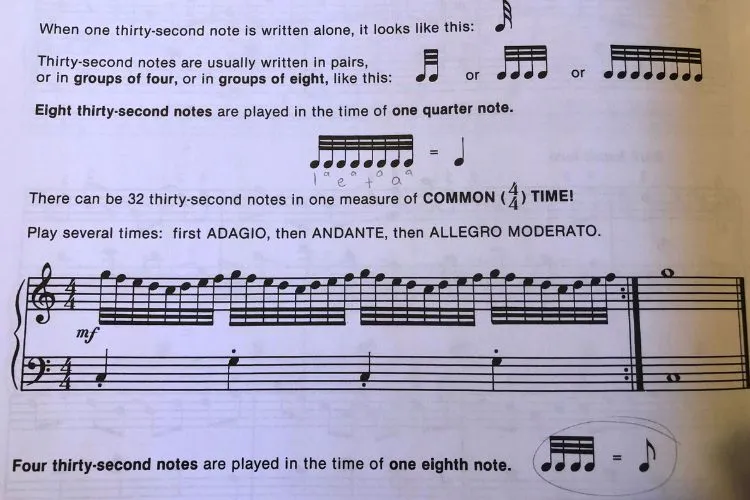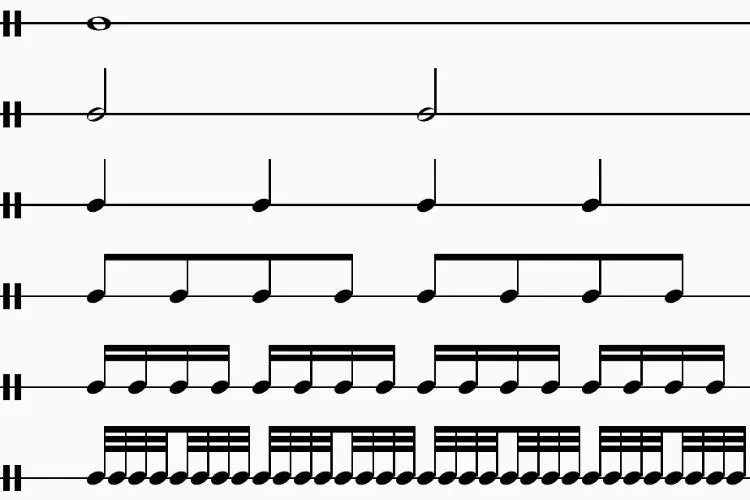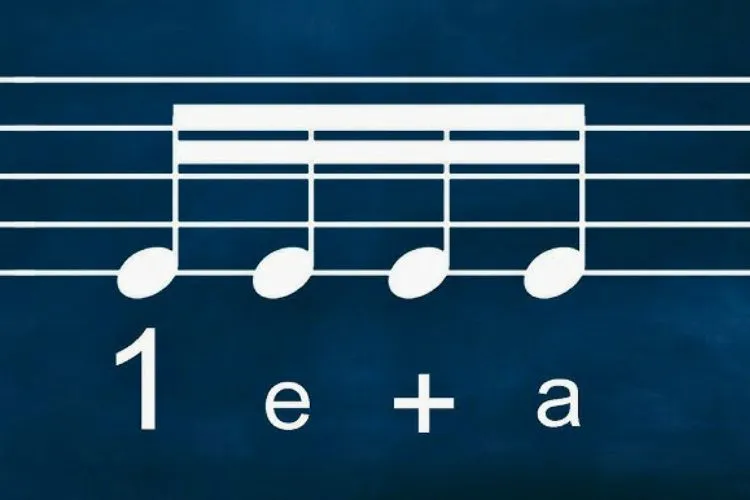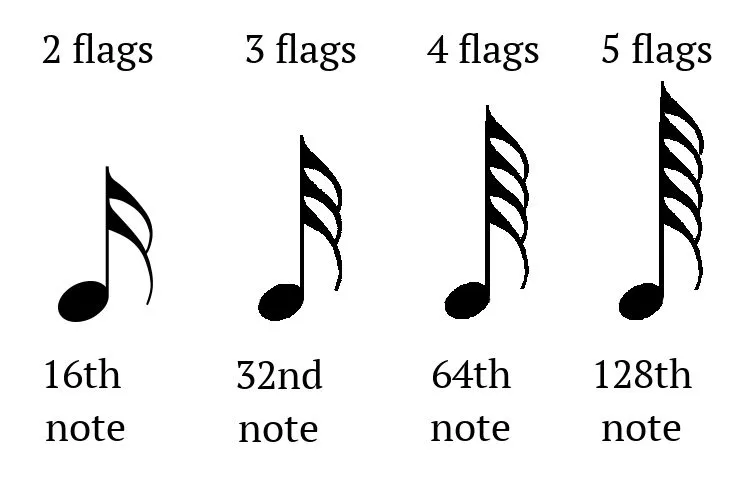Music is an ocean of rhythm, melody, and harmony. Among all, rhythm structures time and creates the movement that drives a piece.
Within this complex framework, 32nd notes come into play. But, do you know how to count 32nd notes accurately?
They may be tiny and quick, but they play an essential role in creating the subtle rhythmic patterns that shape music’s essence.

In light of their vital role, this guide aims to make the process of counting 32nd notes understandable and manageable.
Contents
- 1 🎶Understanding 32nd Notes
- 2 🎶How To Count 32nd Notes?
- 3 🎶Practical Guide to Counting 32nd Notes
- 4 🎶Exercises and Practice Techniques
- 5 🎶Advanced Techniques and Variations
- 6 🎶Application in Different Musical Contexts
- 7 🎶Tools and Resources
- 8 🎶Mental Practicing and Visualization
- 9 🎶Frequently Asked Questions (FAQs)
🎶Understanding 32nd Notes
When it comes to music notation, deciphering 32nd notes can be a challenge. They are recognized by their oval note head, a stem, and five flags or beams connecting them with other 32nd notes.

They essentially depict very quick subdivisions of a beat in music, often seen buzzing across a piece and adding a rush of exciting rhythm.
Comparatively, a 32nd note is half the value of a sixteenth note and an eighth of a quarter note. You will encounter these brisk notes in swift tempo pieces, buzzing around like bees, adding exciting vibrancy to the composition.
Many times, these notes are shown on sheet music, linked together on a stem collecting dust due to their often daunted reputation.
🎶How To Count 32nd Notes?
Counting 32nd notes involves an understanding of beats per minute (BPM), time signatures, and the concept of subdivision.
BPM refers to the pacing of your piece, whilst a time signature tells you how many beats are in each measure. Often seen in pairs at the beginning of a piece like ‘4/4’, ‘2/4’, and ‘3/4’, they indicate the number of beats that fit in every bar. Subdivision, on the other hand, involves splitting a beat into smaller pieces.
To count 32nd notes, you first need to understand how to subdivide the beats. A 32nd note is the fifth level of subdivision, being one-half of a 16th note, one-fourth of an 8th note, one-eighth of a quarter note, and one-sixteenth of a half note.
🎶Practical Guide to Counting 32nd Notes
Diving deeper into counting 32nd notes, a few practical steps should be considered. First, to count such swift notes, it’s crucial to slow your tempo down. Minimize the BPM on your metronome, this can make the counting process more manageable.

The use of a metronome will keep your pace steady, and ensure your counts per beat are accurate. Remember, practice does not make perfect – perfect practice makes perfect. Use your metronome to create perfect practices.
Another helpful strategy is to break down complex rhythmic patterns into smaller, more manageable pieces. By dividing complicated 32nd-note sequences into simpler segments, you will not only understand them better but also reinforce your counting accuracy.
🎶Exercises and Practice Techniques
Learning to play 32nd notes smoothly takes practice. So much so, that playing these notes in sync with the tempo without getting exhausted might feel like a marathon at times.
However, the more you run, the more stamina you gain. That’s why a routine of repetitive exercises is crucial to master 32nd notes. Allow yourself the luxury of starting slow.
Fumbling is a part of the learning phase. Don’t rush through the process, let the rhythm flow naturally. As your hands get accustomed to the tempo, increase your speed gradually.
🎶Advanced Techniques and Variations
As with any musical aspect, virtuosity in 32nd notes also involves mastering advanced techniques. One of the more common applications is the 32nd note triplet. This can be a bit tricky as it involves cramming three notes in the time usually taken by two.

Counting these notes can be challenging but also rewarding when done correctly. The process is similar to counting standard 32nd notes, but with a shift in emphasis to accommodate the triplet feel.
🎶Application in Different Musical Contexts
A mastery of 32nd notes, just like any other musical skill, is rewarding when it adds value to your music. Fortunately, 32nd notes are not genre-specific.
Whether you play classical piano pieces, strum a jazz tune on your guitar, or compose a rock anthem, these quick notes can add an intricate rhythmic texture to your music and are tools for creative expression.
🎶Tools and Resources
In the age of digital engagement, there are several online tools and resources at your disposal. Metronomic apps can aid in mastering the rhythm, while various music theory websites host illustrative tutorials.
Among these, SightReadingMastery and Percussive Arts Society Online are particularly useful. These platforms provide deeper insights into musical notes, their values, and relation to other notes.
🎶Mental Practicing and Visualization
Mental practicing and visualization stand as powerful tools in a musician’s arsenal, particularly when mastering the brisk pace of 32nd notes. When away from their instrument, musicians can mentally rehearse these nimble notes, envisioning the precise movements and rhythms required.

This form of practice promotes muscle memory without physical execution, reinforcing the mental pathways necessary for when they do play.
By imagining the performance of 32nd notes — feeling the tempo, hearing the notes in their mind’s ear, and seeing the notation — musicians actively engage with the music internally.
This technique not only bolsters comprehension but also enhances confidence, leading to a more natural and fluid execution during actual performance.
🎶Frequently Asked Questions (FAQs)
In a 4/4 time, where a quarter note represents one beat, a 32nd note would be the eighth part of a beat.
Absolutely. A metronome will help you maintain a steady tempo while counting 32nd notes, and it is highly recommended in your practice routines.
One common mistake is rushing through the notes. 32nd notes need patience and careful counting. Make sure to practice at a slow tempo initially and gradually increase your speed.
Conclusion
The world of rhythm and time in music can seem daunting. To navigate it successfully, breaking down each element to its most basic form is important — in this case, understanding and mastering 32nd notes.
Remember, the art of playing 32nd notes lies in practice — repetitive, consistent practice.
